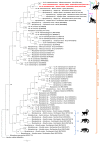First Report of ' Candidatus Mycoplasma haematomacacae' in Laboratory-Kept Rhesus Monkeys (Macaca mulatta) Maintained in Rio de Janeiro, Brazil
- PMID: 36006358
- PMCID: PMC9414003
- DOI: 10.3390/vetsci9080443
First Report of ' Candidatus Mycoplasma haematomacacae' in Laboratory-Kept Rhesus Monkeys (Macaca mulatta) Maintained in Rio de Janeiro, Brazil
Abstract
Health monitoring programs in animals used as experimental models are essential, since only disease-free subjects are considered suitable for research purposes. In laboratory-kept animals, hemoplasmas have been described as an important confounding variable. Different hemoplasma species have been detected infecting non-human primates (NHP) from Brazil. However, the occurrence of hemoplasma species in laboratory-kept NHP in Brazil has not-yet been assessed. Accordingly, this study aimed (i) to screen laboratory-kept rhesus monkeys for hemoplasmas, (ii) to verify if any of the hemoplasma-positive animals demonstrate hematological abnormalities, and (iii) to assess the genotype diversity of hemoplasma species in NHP from Brazil. Five out of eight (62.5%; 95% CI: 3.05-8.63) rhesus monkeys tested positive for hemotropic Mycoplasma spp. by PCR. Sequencing, phylogenetic, distance, and genotype diversity analyses of partial 16S rRNA gene demonstrate that rhesus monkeys were infected by 'Candidatus Mycoplasma haematomacacae' (formerly 'Candidatus Mycoplasma haemomacaque'). Assessments of partial 16S rRNA diversity of hemoplasma species in NHP suggest that at least four genetically diverse groups may occur in Brazil. Although no hematological abnormalities were demonstrated in rhesus monkeys evaluated herein, future studies are needed to elucidate the influence of 'Ca. M. haematomacacae' as a confounding variable on research studies.
Keywords: animal experimentation; genetic diversity; hemotropic Mycoplasma spp.; hemotropic mycoplasmas; laboratory animals.
Conflict of interest statement
The authors declared no conflict of interest.
Figures



Similar articles
-
Multi-locus sequence analysis of 'Candidatus Mycoplasma haematomacacae' in free-ranging macaques from Thailand suggestive of a closer relationship to hemotropic mycoplasmas in capuchins and potential origin from bats.Acta Trop. 2024 Apr;252:107156. doi: 10.1016/j.actatropica.2024.107156. Epub 2024 Feb 20. Acta Trop. 2024. PMID: 38387771
-
'Candidatus Mycoplasma haematohydrochoerus', a novel hemoplasma species in capybaras (Hydrochoerus hydrochaeris) from Brazil.Infect Genet Evol. 2021 Sep;93:104988. doi: 10.1016/j.meegid.2021.104988. Epub 2021 Jun 30. Infect Genet Evol. 2021. PMID: 34214674
-
Genetic diversity and hematological and biochemical alterations in Alouatta primates naturally infected with hemoplasmas in Brazil.Comp Immunol Microbiol Infect Dis. 2019 Apr;63:104-111. doi: 10.1016/j.cimid.2019.01.011. Epub 2019 Jan 23. Comp Immunol Microbiol Infect Dis. 2019. PMID: 30961804
-
A review of the occurrence of hemoplasmas (hemotrophic mycoplasmas) in Brazil.Rev Bras Parasitol Vet. 2009 Jul-Sep;18(3):1-7. doi: 10.4322/rbpv.01803001. Rev Bras Parasitol Vet. 2009. PMID: 19772768 Review.
-
From Haemobartonella to hemoplasma: molecular methods provide new insights.Vet Microbiol. 2007 Dec 15;125(3-4):197-209. doi: 10.1016/j.vetmic.2007.06.027. Epub 2007 Jul 7. Vet Microbiol. 2007. PMID: 17706380 Review.
References
-
- Institute of Medicine and National Research Council . Use of Laboratory Animals in Biomedical and Behavioral Research. The National Academies Press; Washington, DC, USA: 1998. - DOI
-
- Bernacky B.J., Gibson S.V., Keeling M.E., Abee C.R. Laboratory Animal Medicine. 2nd ed. Academic Press; San Diego, CA, USA: 2002. Nonhuman Primates.
LinkOut - more resources
Full Text Sources
Miscellaneous

